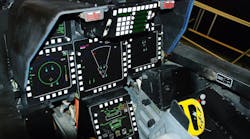By John Keller
Physical security, logistics, supply-chain management, and the proliferation of wireless networks are driving manufacturers of rugged handheld computers and personal digital assistants (PDAs) to add specialty capabilities and make their devices more rugged than ever before.
The post-9/11 world calls for a wide variety of security-screening capabilities in airports, seaports, and sensitive areas such as nuclear power plants, and the latest generation of rugged handhelds and PDAs offer a raft of new options.
At the same time, rugged handhelds and PDAs are seeing plenty of military and aerospace use at security checkpoints, for logistics planning, and even for battlefield command and control.
“In our experience this year, the market is rapidly expanding and the customer is much more specific and specialized in applications of handheld computing,” says Brian Aldham, director of products and solutions at DAP Technologies Corp. in Quebec City.
“Our development this year involves attaching peripheral devices or specialty features to meet specific application requirements,” Aldham says. “Most of our development goes to security-type applications such as biometrics and other technologies that enable this kind of technology to be used in a real way for security for government agencies.”
This customer requirement for specialty applications often can elbow out what Aldham calls “off-the-shelf generic vanilla-flavored models that won’t meet the bill.”
Amrel Systems Inc. in El Monte, Calif., is following this trend with the company’s Rocky Patriot DA4-M rugged handheld, which has mobID biometric security application software “to offer the military and homeland security forces the most advanced PDA biometric identification application on the market today,” says Amrel Communications Coordinator Brooke Nenadal.
As a biometric identification device, the Patriot PDA can be equipped with advanced biometric identification abilities including 2-D/3-D facial, fingerprint, voice, and iris recognition, Nenadal says. Units are available with voice recognition so users can access files while conducting other tasks.
Designers at MicroSlate Inc. in Brossard, Quebec, are specializing their MSL 1500 rugged handheld computer with a barcode reader for logistics and security tracking, says Ed Mendoza, the company’s vice president of sales.
For the near future, MicroSlate designers are planning to integrate a 1.3-megapixel camera in to the unit to enhance its security applications. With such a device security personnel could take pictures of people and send them wirelessly to databases where other security personnel could confirm their identities.
“That’s what people want to see in a handheld-the ability to take pictures and send them wirelessly,” Mendoza says.
The unit also features handwriting recognition and a hardened-glass cover over its touch screen. The hardened glass not only helps protect the unit’s screen, but also eases maintenance in case of breakage. Users most often would simply need to replace the glass cover rather than the entire display, Mendoza says.
For some companies, the objective centers on increasing ruggedness against shock, vibration, and temperature extremes, as well as reducing size and weight and increasing performance.
“Users always want lighter, tougher, faster, with screens that are brighter,” says Mark Dessommes, marketing director of LXE Inc. in Norcross, Ga. “Our customers must be able to read these things indoors and outdoors.”
At LXE the MX5 rugged handheld has an optional radio-frequency-identification (RFID) reader for users screening people coming out of restricted areas. “This unit can scan a security badge and wireless receive a picture of the person who has the badge,” Dessommes says.
“Our customers are also using them to do asset tracking out in the field, such as reading an RFID tag on a piece of equipment or a container. They can know what is in the container without opening it up.”
The growing use of wireless networks inside and outside the military is having a great influence on how rugged today’s handhelds and PDAs need to be, says Vince Menzione, vice president of public sector marketing at Itronix in Spokane, Wash.
“Our devices are actually going to be more rugged because of networking requirements,” he says.
Wireless networking, Menzione says, is moving rugged computers from inside the plants and warehouses to the outdoors. “You are no longer constrained by the signal coverage of a building or even a campus. Ubiquitous wireless coverage is driving the ability to use the computer in more hostile environments, with heat, sand, and moisture.”
Itronix, which is being acquired by the General Dynamics C4 Systems division in Taunton, Mass., is selling rugged handheld computers to Continental Airlines for tracking and maintenance applications on the airport tarmac.
Click here to download a .PDF of rugged handheld computers and PDAs


